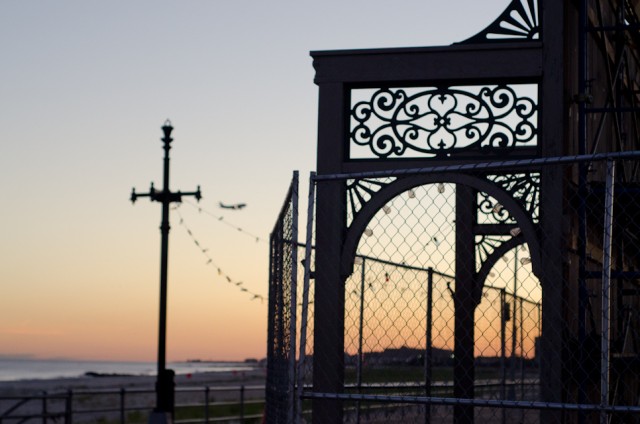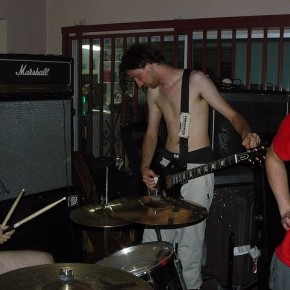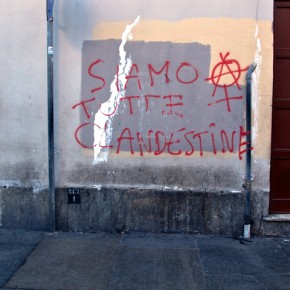Our cultural fascination with decay is pervasive and profound. The visual vocabulary of ruination connects the decay of built spaces to the aging of human bodies: a death spectacle. But in the Rockaways, New York City’s thin ribbon of battered coastline, we discover that the vulgar voyeurism of the decay-seeking gaze is more closely connected to our social understanding of wealth than to our animal understanding of death.
For a few weeks this summer, an abandoned television set constructed for the HBO series Boardwalk Empire stood on the empty, storm-abused boardwalk at Beach 44th St. in Rockaway, Queens. Diagonal poles and pyramid-stacked sandbags supported the flat replicas of prohibition-era boardwalk buildings. The short line of building facades included an antique-looking “transient hotel” and a popcorn parlor boasting of exaggeratedly low prices– architectural imitations of the gritty aesthetic of the speakeasy, erected to tickle a cultural imagining of Atlantic City in the roaring twenties. The television set faced the ocean, where the frothy waves characteristic of Rockaway in late summer struck the sand and left foamy spit-streaks on a stretch of beach still decimated by last October’s Hurricane Sandy.
To those traveling eastward on the above ground A-train toward economically depressed and politically neglected Far Rockaway, looking down at the torn-up 44th street boardwalk from the raised track, or to the hundreds of New Yorkers living in recently rehabilitated homes just paces from the beach, or to the ignored and mistreated residents of the Edgemere Houses, one of New York City’s most neglected housing projects, looking down at the crumbled beachfront from their windows embedded in the project’s filthy brick, this television set must have seemed silly and bizarre — a hollow diorama of a century-old decay, propped against the fresh ruination of the Rockaways.
Even when not held hostage by the destruction of a recent hurricane, Rockaway is austere. This is a landscape defined by severity; built and natural systems intersect in such a way that ruggedness and spent utility become the dominant aesthetics of the peninsula. The region is underserved by public transportation. Chain-link fencing meanders unbridled. Public housing projects deteriorate unseen in the shadow of the raised train track. There are huge lots of dug-up ground that seem to exist only to store idle construction equipment. It is a common line: Rockaway exists to be a kind of dumping ground for the city at large, a string splayed out along the border of the most distant periphery of New York City, where all kinds of debris are sent to be forgotten. And the Boardwalk Empire set, stranded on the exposed boardwalk for those weeks in August, seemed to be no exception. It was an artifact of both cultural and material debris.
It should be obvious that there is a profound cultural fascination with decay, with ruination, with the faux-natural process of deterioration through which the shiny and novel is made antique. The phrase “ruin porn” has recently entered the lexicon of Internet-birthed photography terminology; it describes an entire genre of photography that exists to capture the crumbling facades and dilapidated interiors of abandoned buildings. Similarly, the mythology of ghost towns and abandoned inner city ghettos continues to exist as a powerful semantic marker. It bears both ghostly profundity and an entirely elastic set of meanings: an image of boarded-up Detroit can evoke nostalgia, or pseudo-political dissatisfaction, or gratitude for the comforts of contemporary modernity; a ghost town can indicate both ecstatic openness and eerie claustrophobia. And certainly the resonance of ruination hasn’t been lost on literary types– among Shelley’s most famous sonnets is “Ozymandias,” his love letter to a toppled statue, and Derek Walcott, while speaking about the importance of internalized narratives of history in his Nobel Prize speech, reminds us solemnly that “the sigh of History rises over ruins.”
In Detroit Ruin Porn and the Fetish for Decay, Kyle Chayka tries to explain this desire to gaze upon the crumbled: “The voyeurism isn’t just gawking at the old buildings; it’s gawking at the possibility and the danger of death.” And analysts of Shelley’s poem often draw the same conclusion: that the cultural importance of ruination is a collective expression of our individual preoccupations with mortality. Buildings, cities, and, for Shelley and Walcott, entire societies perform a kind of death-spectacle which we human beings, excruciatingly aware of the inevitability of our own ruin, interpret as both unsettling and cathartic. And of course this duality is the home turf of art and the terrain of cultural mythology.
But this perspective begins to collapse if we demystify the actual material connection between ruination and dying. Because landscapes of gradual decay are very different from, say, portraits of bombed-out cities; the gradual deterioration of space doesn’t necessarily connote human death, except in the sense that it evokes a chilling symmetry between the processes experienced by an abandoned building and a human corpse. In fact, far more often a decayed cityscape is actually indicative of an abundance of life– of overpopulation, of squatting, of the rapid and sudden displacement of people because of aggressive market momentums and wealth mobility.
For some, the experience of Hurricane Sandy and the ensuing recovery helped to solidify the attitude held by many residents of the Rockaways: that the populations living along New York City’s coastal periphery are disposable people held hostage by decay. The far-flung string of land that already serves as a dumping ground for so much industrial garbage and abandoned infrastructure is also a kind of dumping ground for human debris: men and women weeded out of the city’s nucleus by the violence of New York City’s neoliberal takeover. Because the truth is that, even as the built landscape of Rockaway continues more and more to reflect the material life of crisis we interpret as ruination, its human population is growing incredibly. This was noticed as far back as 2008, when Rockaway newspaper The Wave reported a staggering increase of 9,032 people living on the peninsula: a growth of nearly 10% in one year.
These are not the ruins of Rome; people live in these ruins. A visual perspective that excludes this fact by dwelling upon emptiness and idleness is no valid perspective at all. Perhaps our cultural fascination with ruined spaces, the voyeurism of the decay-seeking gaze, is more similar to the bourgeois impulse to gawk at poverty and commodify its modes of expression than the human craving for death-spectacle. Perhaps the vulgar popularity of ruin porn is more closely connected to our social understanding of wealth than to our animal understanding of death.
Last May, hip clothing-maker Brooklyn Industries unveiled a line of summer clothing called Rockaway Revisited. Their marketing campaign was oriented around a series of photographs depicting models playing in the post-hurricane debris. Taken days after the storm, the photographs include many shots of the mangled boardwalk, including several images of models lounging on the naked anvil-shaped supports. Other models climb over landscapes of toppled fencing and sand-wrecked streets. The response from New Yorkers was immediate and vitriolic; the news blog Sheepshead Bites ran the story with the headline Brooklyn Industries Exploiting Sandy Disaster Areas for Tasteless Photo Shoot and widely-read news source Gothamist described the marketing campaign as “tone-deaf.”
The strength of this negative response is particularly interesting considering the popularity and near-universally accepted artistic validity of ruin and disaster photography that does not feature models or corporate watermarks. For example, Gothamist itself has routinely run photo features on abandoned and dilapidated spaces around New York, including several very striking photo sets of the Sandy-damaged boardwalk. This controversy demonstrates just how powerful the cultural resonance of ruined spaces can be in popular imagination. And the photos themselves complicate still further the association of ruin with death; the images published by Brooklyn Industries to sell their clothing to young super-hip New Yorkers are images of youth and vitality and daring, not gestures toward a proto-societal awareness of the transience of life.
Pretty young people in new clothes traipsing through the rubble of a hurricane-smashed beachfront: this is a particular kind of late-capitalist fantasy. Not only is it Gatsby-like– the self-conscious novelty of wealth, plus a contradictory nostalgia for an imagined age of opulence– but it also seems to reflect a cultural absorption of risk, a recognition that obsolescence and abandonment are as much cornerstones of free market mythology as innovation and consistency.
So in a big way, the idea these pictures are projecting is risk: risk of collapse, risk of failure, risk even as the very essence of newness, the way in which we recognize youth. This pulls us still further away from the notion of death-spectacle, and towards a much different hypothesis: that the popular fascination with ruination is a cultural effect of capitalism’s perpetual climate of crisis, and the consistency and universality of risk.
Our collective preoccupation with ruinous decay may be best understood as a cultural reflection of capitalism’s hyperproductivity. The collective endeavor of seeking out and gazing upon abandoned spaces can be understood as a cultural ripple of one of capitalism’s most central internal logics: that productivity is emphasized over permanence, and even our greatest constructions — cities, buildings, societies — are constructed because of their potential to provoke further construction. Implicit within the grand unifying myth of capitalist ideology— that competitive innovation is the engine of human development — is the universality of planned obsolescence. An abandoned building is an obsolete building. It is not such a leap to surmise that an obsolete population– one largely excluded from the churning market mechanisms of post-industrial New York — will be an abandoned one. And from there the mechanisms that drive the deterioration of man-made space become more visible, stripped of their heroic mythology of stoic death.
There is an unavoidable difference between the death of a body and the death of a built landscape. The death of a body is natural, authentic, ordained. Ruination is something else entirely– the decay of a building is a contrived death, manufactured by the same logic of production and expansion that created the conditions of its construction. It is perhaps meaningful that at the time of Shelley’s ode to a fallen statue– a time when the trope of poet-leaves-the-noisy-city-to-contemplate-the-crumbling-chapel became a full-fledged cliche– the cacophony of free market overproduction was just beginning to find its first truly modern expression in the form of crown-sponsored charter-colonies and the frenetic global sea trade. And today, in global capitalism’s feverish climate of perpetual crisis and recovery, as the centrality of obsolescence and abandonment to the mythology of overproduction is made unmistakably apparent, it should come as no surprise that internalization of risk and suspicion of permanence find profound collective expression in our cultural fascination with ruin. Because what is ruination but the material life of crisis?
The television set perched on that isolated stretch of boardwalk in Rockaway, surrounded by storm-battered beach and framed by the austere landscape of public housing and raised train track behind it– this is a certain kind of portraiture, and a powerful visual cue. Our collective fascination with ruin doesn’t reflect an interest in fact or in history, or even a preoccupation with death. It reflects only our investment in a fictionalized idea of progress, and the corresponding self-congratulatory nostalgia for what never was.
The decay-seeking gaze does nothing to examine, or dissect, or uncover. Like the television set propped for a few weeks this summer against the ruins of a recent disaster area, it only distracts and obscures.
Photographs courtesy of Alexis Lim. All rights reserved.












